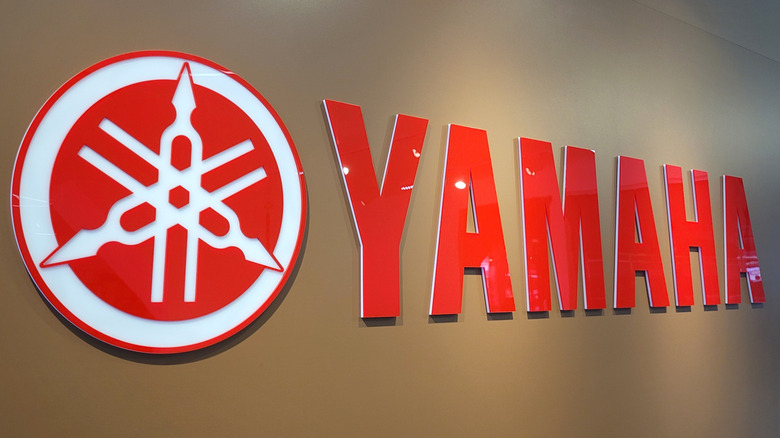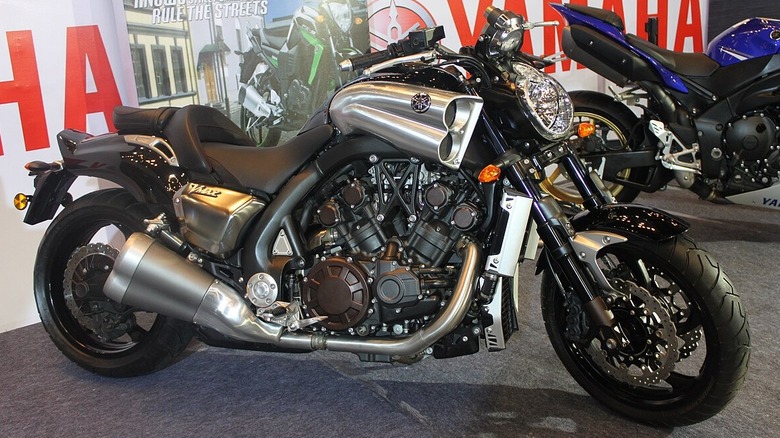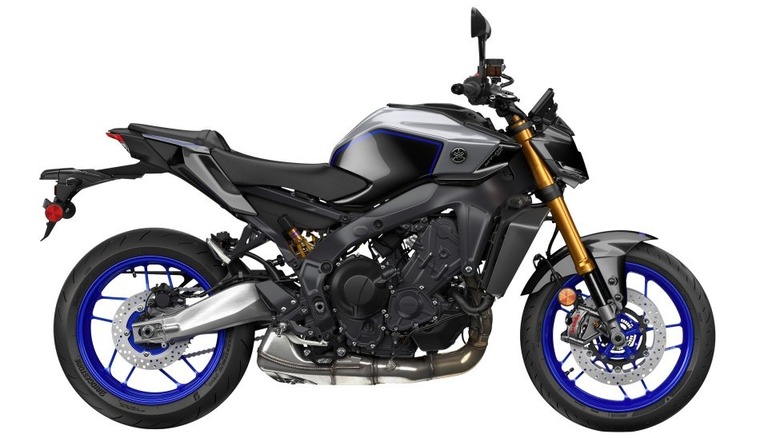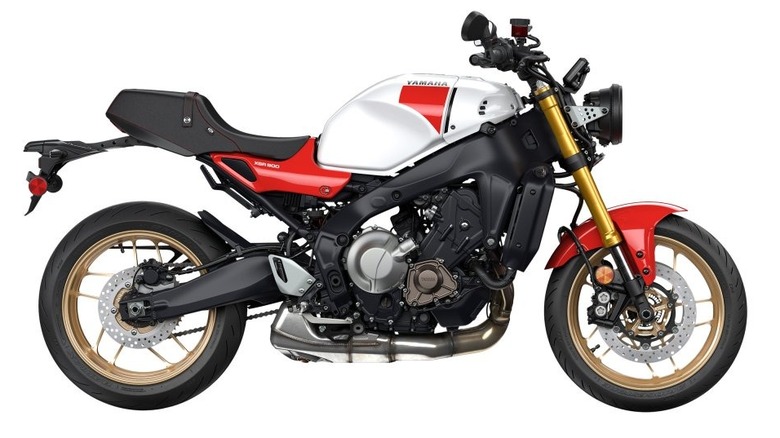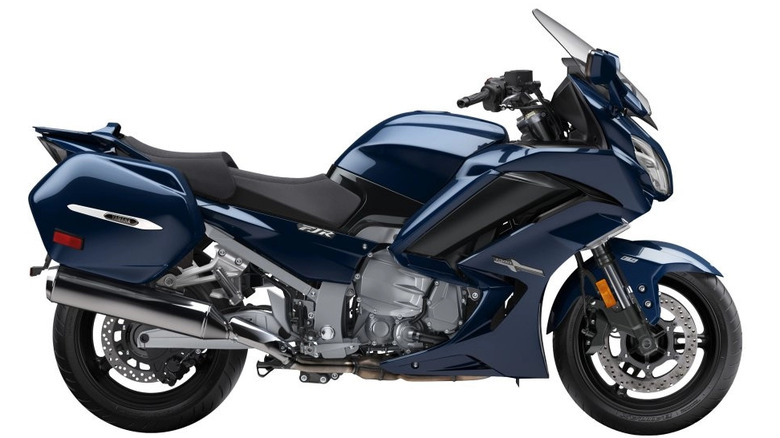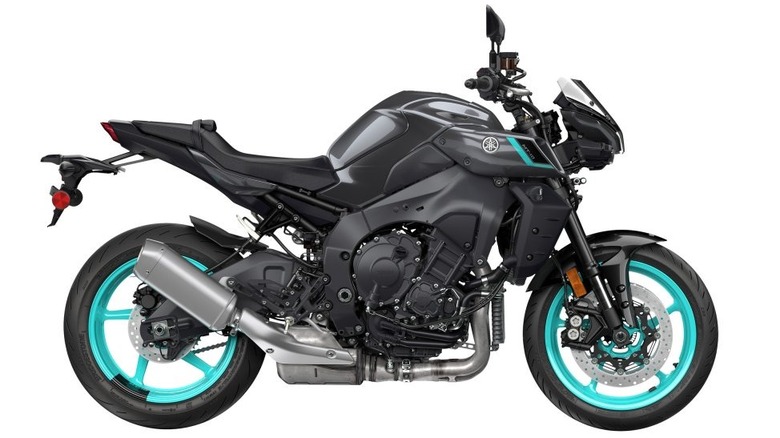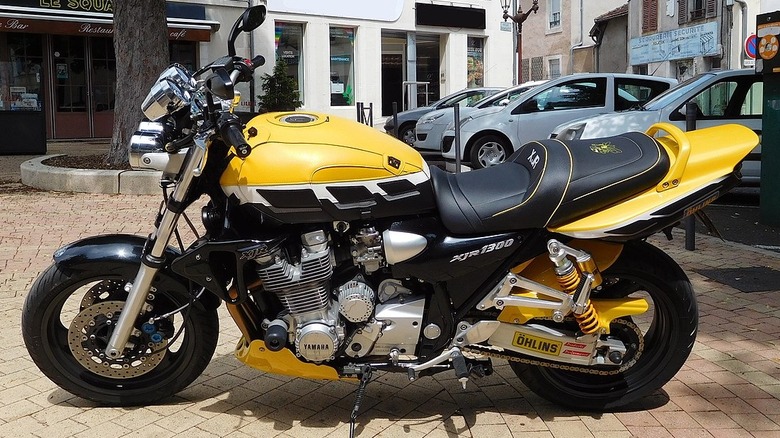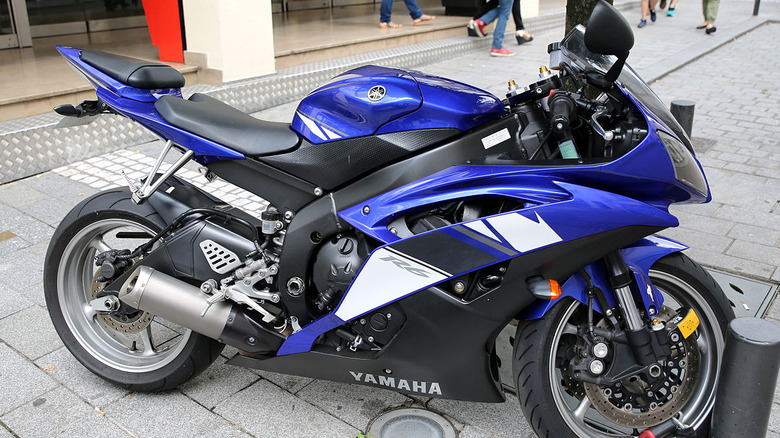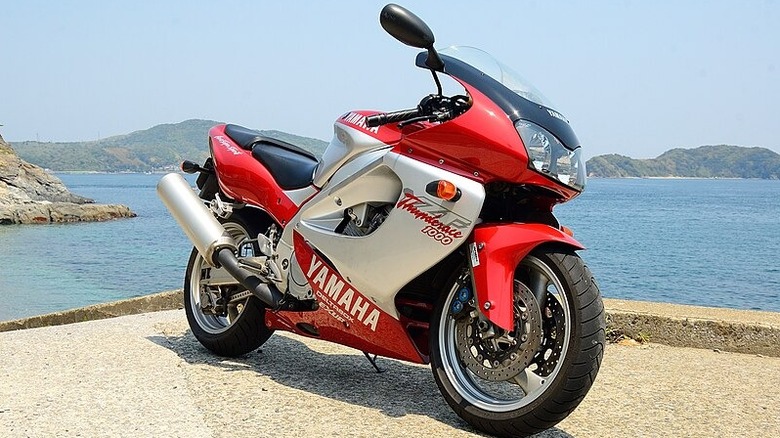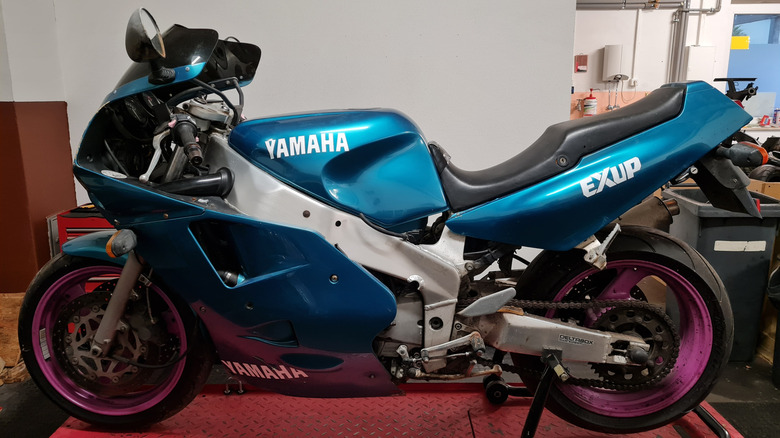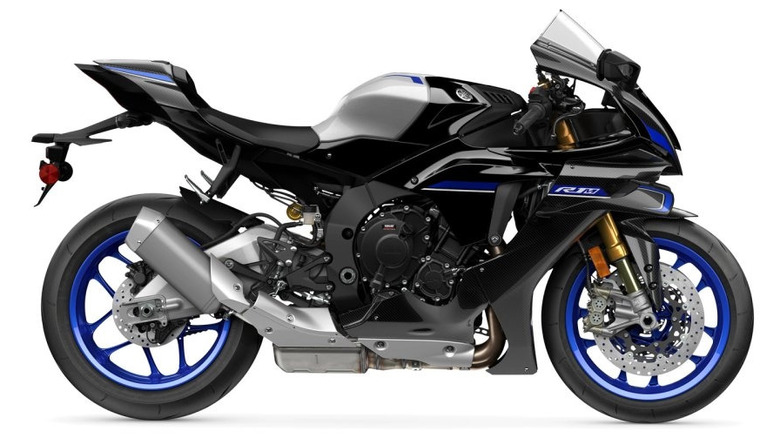10 Of The Fastest Yamaha Motorcycles Ever Made, Ranked By Top Speed
Founded in 1887 as a piano and reed manufacturer, the Yamaha Corporation didn't make its first motorcycle until 40 years after its founder's death. Debuting in 1955, the YA-1 was a 125cc single-cylinder two-stroke street bike, and it didn't exactly set the world on fire. However, it set the stage for Yamaha to grow into the motorcycle producer it is today.
An international conglomerate with factories all over the world, Yamaha now builds a wide range of motorcycles. With decades of racing success and millions of units sold, it has consistently developed its bikes to keep up with the cutting edge.
Locked in constant rivalry with the likes of Honda, Suzuki, Kawasaki, BMW, Ducati, and Aprilia, Yamaha sits squarely in the middle of a oneupmanship competition. And as a result, it has produced some of the fastest bikes of the last 30 years. In honor of the blue blurs that run roughshod over public streets and racetracks alike, let's run down 10 of the fastest Yamaha motorcycles ever made, ranked by top speed.
V-Max — 138 mph
Debuting in 1985, the Yamaha V-Max is the motorcycle that inspired Cloud Strife's getaway bike in "Final Fantasy VII." But in real life, the distinctive drag demon carved itself a reputation for wild power in a muscle-cruiser package.
The V-Max endured for 10 generations over 35 years, during which time its displacement bumped from the 1985 model's 1,198cc to the final 2020 model's 1,679cc. A claimed 170 to 200 hp (the 2010 model made 173.9 hp at 9,000 RPM and 113 lb-ft of torque in a Cycleworld test) gives it superbike numbers. Somewhat hampered by its 683-pound weight, the V-Max doesn't have the flickability of a supersport, but it was built for the drag strip rather than the twisties.
Its not-so-secret weapon: a liquid-cooled double overhead cam (DOHC) V4 engine. That's right, the V in V-max stands for its engine configuration, but unlike most Vs in the motorcycling world, this one doesn't have a "twin" after it.
There is some debate over the V-Max's actual top speed. Yamaha governed the motorcycle at 138 mph (222 kph), but it is estimated that the V-Max could attain up to 170 mph (274 kph) unfettered.
The V-Max's ambiguous top speed places it on the low end of our list, but make no mistake, saying it is fast is an understatement. Just ask its 10.11 second quarter-mile time.
MT-09 — 145 mph
Once upon a time, the fastest motorcycles were street-legal track bikes with candy-colored full-farings and a rider triangle the size of a Dorito. But these days, eye-popping speed comes in all kinds of packages. The Yamaha MT family debuted in 2005 with the MT-0, a muscle bike built from a concept unveiled at the 1999 Tokyo Motor Show. By the time the first MT-09 rolled around in 2014, Yamaha had an excellent grasp on what it wanted the bike to be.
The MT stands for Mega Torque, a signal of Yamaha's ambition for the line. MT bikes would focus on usable torque through the low end of the powerband, something four-cylinder, high-revving supersports are occasionally maligned for lacking.
What makes the 2024 Yamaha MT-09 unique is the CP3 powerplant wedged into its cast aluminum twin-spar frame. Like the MT line, the CP3 engine debuted as a prototype, at the Cologne Auto Show in October 2012. A cross-planed triple cylinder, the engine eliminates the RPM flutter suffered by race-oriented four cylinders. Its smooth power delivery differs somewhat from traditional sports bikes.
In 2024, the MT-09 represents the latest and greatest from Yamaha's vision. With an approximate top speed north of 145 mph (233 kph), it is no slouch in the power department. Making 117 hp at 10,000 RPM and 68 lb-ft of torque at 7,000 RPM, the MT-09 is a hyper-naked sport bike not to be trifled with.
XSR 900 — 146 mph
The Yamaha XSR family looks retro, but it is actually one of the more recent additions to the Yamaha family. With a core sourced from the CP3 three-cylinder engine in the older MT line, the XSR offers an entirely distinct experience.
Yamaha based its vision for the XSR on a Japanese proverb that translates to "study the old to better learn the new." Yamaha seems to have reached back to its TZR series, built between 1986 and 1996, for aesthetic inspiration. Though the TZR has a full fairing and the XSR 900 GP is half-naked, the lines of the bike are very similar, with its stepped saddle and aggressive crouch.
The first XSR, the XSR700, appeared in 2009, followed by the XSR900 in 2017. Yamaha grabbed the MT-09's CP3 engine, which made the same 117 hp and 68 lb-ft of torque, but that's where the similarities end. The MT-09 is a street brawler, but the XSR 900 is meant to carve mountain roads, allowing its riders to pretend they are the 1980s and 1990s Grand Prix stars of yore.
The XSR900 GP barely edges the MT-09 out for our top speed laurels with a maximum velocity of 146 mph (235 kph). It is a respectable top speed, but the XSR900's charm lies more around what it can do on a track or your favorite winding roads. Modern, powerful, and possessing a certain vintage charm, the XSR900 GP occupies rarefied air near the top of Yamaha's speed hierarchy.
FJR1300ES — 154 mph
The first traditional four-cylinder sportbike on this list, the FJR1300, has represented the sport-touring market since its inception in 2001. The largest displacement motorcycle in the 2024 Yamaha lineup enters the list.
The 1,298cc DOHC, 16-valve four-cylinder, was designed to provide smooth power on the great open highway. Yamaha hasn't gone out of its way to outfit the FJR1300ES with every imaginable modern contrivance; the model hasn't seen a significant overhaul since 2016. It even has still an analog tachometer. In a world of sexy multi-colored displays, that might be a bit of an anachronism, but we're glad to know there is still a place for the old ways.
The FJR has a twin-spar aluminum frame, electronic suspension, and a modest selection of creature comforts. Anti-lock brakes, dual front 320-millimeter Nissin brake calipers, a 282-millimeter disc rear brake, heated hand grips, adjustable seat windshield, lean-angle sensitive headlight, a glove box with a 12V outlet, and a sixth gear that turns the shaft drive 3,500 RPMs at 75 mph highlight the FJR1300ES's dedication to touring. However, it should be noted that it is no slouch in the performance department.
Even at 642 pounds, the elder statement FJR can achieve a top speed of 154 mph (248 kph). Though that might count for middling in today's hyperperformance world, the FJR remains one of the fastest production motorcycles Yamaha has ever made.
MT-10 SP — 155 mph
It took Yamaha a couple of years to give the MT line the literbike treatment, but in 2016, it debuted the MT-10. Unlike the MT-09, the MT-10 has four cylinders in a 998cc liquid-cooled DOHC configuration, which they have coined the CP4. It gives it that extra oomph at the top end, but that's not where the performance ends.
The MT-10 SP comes with the same aluminum Delta-box frame as the motorcycle that took sport bikes to the next level, the Yamaha YZF-R1. With an electronically controlled Ohlins suspension, dual 320 millimeter discs in the front and a 220 mm disc in the rear, and a compact wheelbase of 55.3 inches, the MT-10 qualifies (at least in the eyes of the Yamaha marketing department) as a hyper naked sportbike.
The CP4 provides plenty of grunt, making 164 hp at 9,400 RPM and 82 lb-ft of torque at 9,200 RPM. All that adds up to a top speed in the 155 mph (250 kph) range. If that sounds a little daunting, Yamaha employs an intriguing system they call the Accelerator Position Sensor Grip (APSG). This ride-by-wire system allows riders to select from four riding modes ranging from wet to track conditions. The MT-10 also includes Yamaha's Variable Speed Limiter (YVSL), which allows riders to choose a preferred top speed beyond which the system will limit speed.
Yamaha clearly takes pride in its MT line. The MT-10 SP's head-turning design, unique exhaust note, and competitive power show why it ranks at the top.
Yamaha XJR 1300 — 160 mph
It might be surprising to see the XJR1300 this high on the list. It looks practically sedate at a glance, but its easygoing styling belies serious power. The XJR line arrived in 1993 as a naked roadster with 400cc displacement. The XJR400 lived until 2007 when emissions regulations forced Yamaha to drop it. But the company didn't give up on the XJR.
The XJR1300 arrived in 1998 as one of Yamaha's most powerful models. It was a muscular bike that could handle the twisties, something experienced riders could enjoy on a daily commute as much as a Sunday ride. To achieve this, engineer Yutaka Kubo, who headed up the YZF and FZR projects, incorporated many of the lessons learned from developing sport bikes.
The final iteration of the XJR 1300 was for the 2011-2012 model year. Its 1,251cc DOHC cylinder makes 98 hp and 79 lb-ft of torque. An Ohlins dual rear shock and dual 298 millimeters disc brakes make it a nimble but powerful bike ideal for narrow roads with high traffic.
Yamaha slapped an EXUP valve in the exhaust, just like on the FZR, and went out with a bang. If you're scratching your head wondering how you missed Yamaha's 160 mph (257 kph) muscle roadster, it's because Yamaha never saw fit to bless the American market with it, sticking to Oceania and Europe.
YZF-R6 — 162 mph
We were sad to see Yamaha discontinue one of its most legendary sport bikes in 2020. The company's premier 600cc supersport, the R6 had served front-line duty in the power wars since 1999. It was the baby brother of the R1, and received some wonderful hand-me-downs from the development of the literbike.
Its last major overhaul occurred in 2017, and it was a doozy. The final iteration of the R6 boasted Yamaha's Deltabox aluminum frame, a KYB suspension, aluminum fuel control, anti-lock Nissin brakes, and traction control with up to six settings, not including the ability to turn it off entirely for a pure rider track experience.
The R6 went out true to form as a high-revving four-cylinder screamer with a 599cc engine making 117 hp at 14,500 RPM and 46 lb-ft of torque at 10,500 RPM. Weighing in at a scant 419 pounds, it was the quintessential middleweight supersport, keeping the revs up and the knees down. Despite its relatively low displacement, it tops out as one of the fastest production motorcycles Yamaha has ever built, with a top speed of 162 mph (260 kph).
Unfortunately, Yamaha had to kiss the R6 goodbye in the name of tough new emissions standards. Yamaha has taken an interesting turn by replacing the R6 with the YZF-R7, a very different motorcycle.
YZF 1000 R Thunderace — 165 mph
On its way to the R1, Yamaha built a number of literbikes, including the YZF 1000R Thunderace. Introduced in 1996, the Thunderace was put on paper as a racer, but it served as an excellent big-bore sport touring bike.
The Thunderace was the original R1, with plenty of power from the 1,003cc five-valve four-cylinder making 147 hp. The last one rolled off the production line for the 2003 model year, meaning that for a golden five years, Yamaha built both the R1 and the Thunderace. Its curved design is a departure from the angular R1 and reminiscent of the glory days of the 1990s.
The Thunderace gets its engine from the FZR 1000 R and its manners from Yamaha's YZF-750R homologation model's borrowed frame. Thanks to the near-simultaneous introduction of the R1, the Thunderace has been underrated and overshadowed, but over time, it has proved to be a favorite of owners who enjoy smooth power delivery and plenty of it.
The Thunderace is still available and tends to be cheaper than the R1. Finding the right one for sale could be a great deal for someone who wants 165 mph (266 kph) in the garage.
FZR1000R EXUP — 170 mph
Though Honda arguably debuted the first superbike in the 1969 CB750, the 1980s saw superbikes evolve into modern form. Amongst them was Yamaha's FZR1000, a fully-faired sportbike that blew away the press at Laguna Seca during its reveal.
Yamaha built the grandfather of the R1 between 1989 and 1995 as a replacement for the FZ750. An alloy Deltabox frame and five valves per cylinder in a four-stroke, liquid-cooled 1,002cc inline four-cylinder made a motorcycle with a 520-pound wet weight, 146 hp at 10,500 RPM, and 79 lb-ft of torque at 8,500 RPM.
Yamaha's Exhaust Ultimate Powervalve (EXUP) system helped the FZR reach its fullest potential. At low RPMS, an exhaust valve remains closed, increasing back pressure in the system, while at high RPMs, the valve opens to allow for a free-flowing race-style exhaust performance. This little trick turned the bike into a verifiable screamer on the track.
The Yamaha could allegedly hit 170 mph (274 kph), giving it a deserved reputation for speed, but unfortunately, poor build quality hit it hard. Warped discs, seized exhaust valves, blown-out rear springs, and a required valve clearance adjustment at 20,000 miles (if they lasted that long to begin with) translated into a somewhat finicky but still very cool machine that is something of a missing link between the rise of the superbike in the early-80s and the Yamaha R-series motorcycles that have enjoyed success from the early-aughts onward.
YZF-R1M — 183 mph
The YZF-R1 has been the undisputed king of the Yamaha supersport line since its debut in 1998. In recent years, manufacturers have offered advanced versions of their literbikes at a premium, and Yamaha's version is the Yamaha YZF-R1M.
The 998cc liquid-cooled in-line four-cylinder DOHC powerplant is available in both Yamaha's R1 offerings (the R1M and standard R1). Making nearly 200 hp at the crankshaft and weighing in at a wet weight of 452 pounds, it is nothing less than the state-of-the-art street-legal superbikes.
Carbon fiber fairings and an upgraded Ohlins electronic racing suspension account for most of the $8,700 difference between the two models. The R1M is ostensibly street-legal but truly built for the track warrior, weekend or otherwise.
The YZF-R1M reigns supreme as Yamaha's master of speed. Though happiest getting low on the track, any good literbike has to be fast, and the R1M is king of the Yamaha pile with a top speed of 183 mph (296 kph).
